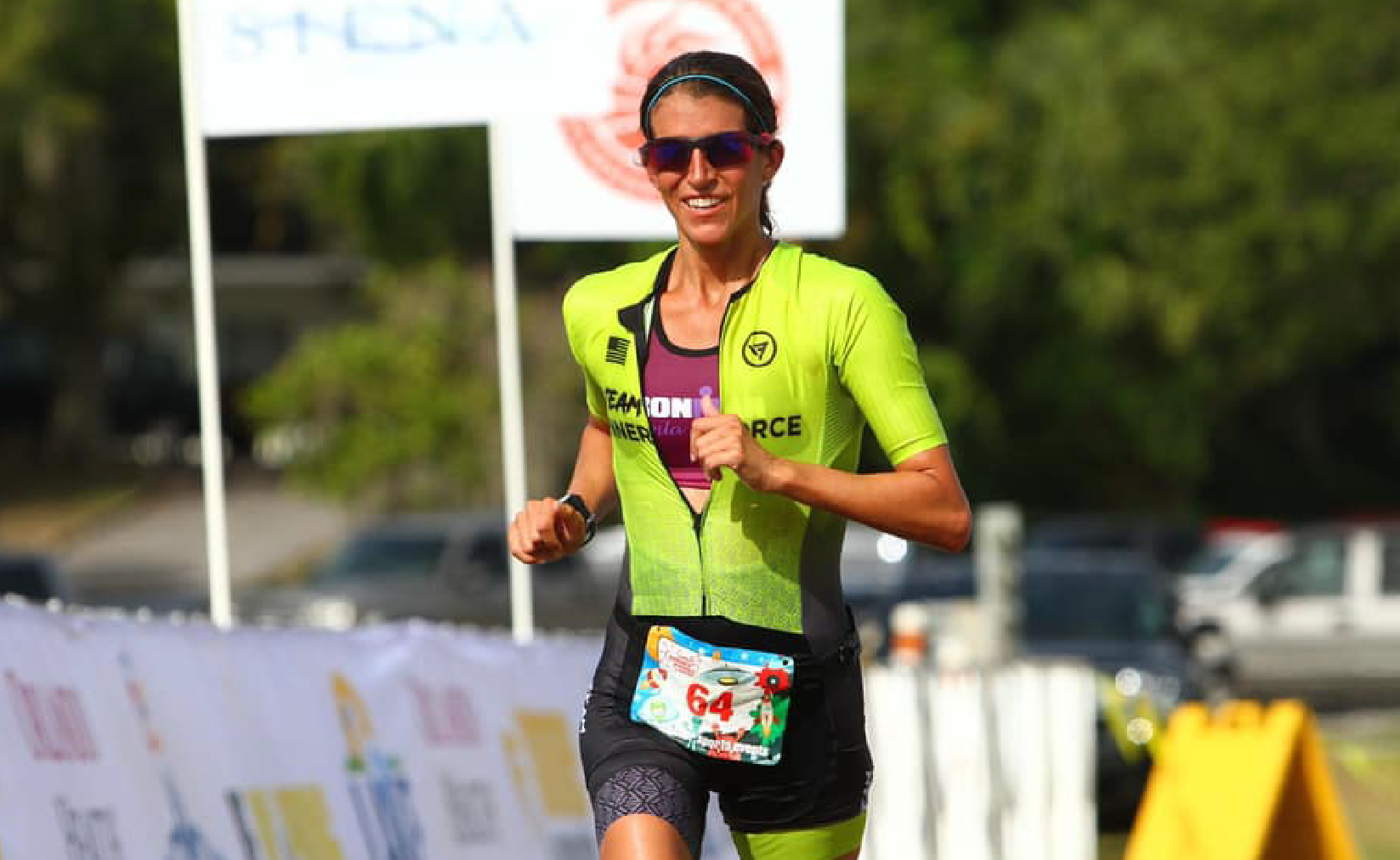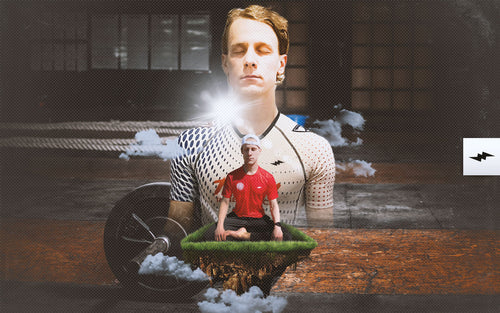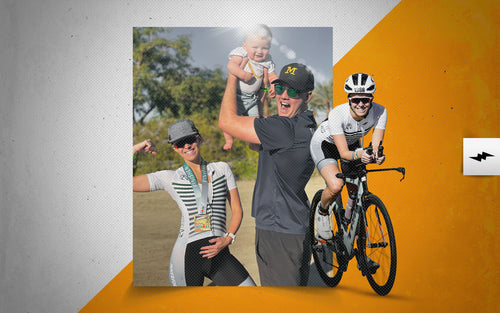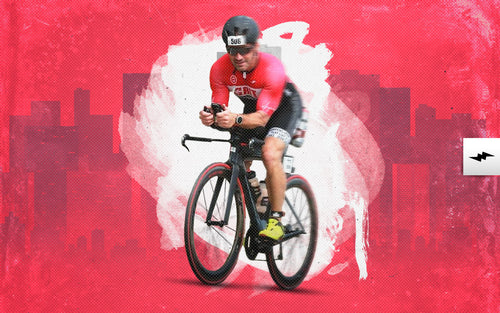Holly Smith: From 'Cheap Aluminum Bikes' to the 70.3 World Championship

Like so many talented endurance athletes it seems, Holly Smith stumbled across triathlon - quite literally, in fact. A dedicated distance runner, Holly ran her first marathon in 2005 at the age of 20 and even qualified for the Boston Marathon a couple of times.
However, around 2010, Holly suffered a stress fracture in her heel - a consequence of running every day. In need of a replacement fitness activity, she began taking spinning classes and enjoyed them so much that when her heel recovered, she decided to add outdoor biking to her running, adopting the logic that it would also minimize the risk of a repeat injury.
“I bought a cheap aluminum bike and started riding on a bike path near my work three to four times a week,” Holly explains. “Then I heard about triathlons and decided to take up swimming so that I would have a new sport to compete in and challenge myself.
“I started off with a sprint triathlon, then an Olympic length race. My goal at that time was to work up to a half Ironman, with really no thought of ever being able to complete a full distance race. But after my first 70.3 race, I knew that I had to keep challenging myself and set my goals to running a full-length Ironman the following year.
“In 2015 I finished my first full Ironman at Louisville, and have not looked back ever since. It is such a thrill to be able to train and compete in three different sports and to push yourself to limits you didn’t think were possible.”
Since then, Holly has indeed kept pushing her limits. Another five full-length Ironman races have been completed with a sixth-place finish in her age group in the most recent. A place at the World Championships in Kona may have eluded her so far, but she recently achieved a major milestone in the 70.3 distance: qualifying for the 70.3 World Championships in Nice after placing third in her age group at Ironman Gulf Coast 70.3.
“The crazy thing was I had not even planned on racing this event,” Holly says “I had just done Ironman Texas two weeks before and did not feel that my body was fully recovered yet. However, I had the opportunity to race and figured I would give it a go!”
Following her qualification for Nice, Innerforce spoke to Holly about her triathlon history, how she prepares for races, what a typical training week looks like, and the advice she would give to others based on her experiences.

.
When and where was your first triathlon? How was that experience?
My first triathlon was a sprint distance race in my hometown of Battle Creek, Michigan in August 2013. I really had no idea what I was doing. I had my cheap aluminum bike, had never heard of aero helmets or race belts, and had not once done any open water swimming. I didn’t even know that people wore wetsuits for the swim!
Needless to say, I was completely unprepared and it was kind of a mess when things started. Within minutes of getting in the water my goggles had been kicked off and I had swimmers climbing all over me.
I seriously thought I was going to drown and nearly called over one of the lifeboats. But I regained some composure and made it through, mainly doing breaststroke the rest of the way so I could keep my head above water. It was only a 750 meter swim but it took me over 20 minutes to finish and I was nearly the last one out of the water.
But I did catch up on the bike and run, and ended up winning my age group! (It was a very small local race, but after the way things started I was pretty happy about the result).
After that race I remember talking to my mom and telling her I would not be able to continue doing triathlons, mainly because of the swim. I couldn’t imagine doing long distance swimming with an even bigger crowd. But after a few days, the awesome experience of racing came back to me and I knew I would just need to practice and be more prepared to race triathlons in the future.
I bought a wetsuit and started training in the open water. Eight months later I raced and won my age group in an olympic length event. After that, I was hooked.
What are some of the biggest challenges you have faced on your triathlon journey so far?
Swimming has always been my biggest challenge. I never was a swimmer in high school or college, and had never done any masters classes or joined any swim leagues. I basically trained myself to swim by watching videos and swimming laps on my own.
My other big challenge when I first started doing triathlons was finding time to train. I am a physician, and when I first started doing triathlons I was still in residency. Since I was working 60-80 hours a week, this left little time for training. I often would get up at 4 am to swim or run so that I could be at the hospital by 6.
Other days I would bike late in the day after finishing work. But I loved the sport so much that I would always find the time to get in long training sessions. I hear many people making the excuse about not having the time to workout or train, however if you truly want to achieve something you make time.

.
You recently qualified for the 70.3 World Championships. What are your goals for Nice?
Just to qualify was such an amazing achievement for me. Of course, I want to have a great race out there, but I also want to enjoy the overall experience and take in the fact that I get to race with the world’s best triathletes that day. I would really love to break the five-hour mark that day.
Will your preparation change in any way ahead of such a big event like the World Championships?
I recently checked out the course in Nice, and like the 2017 World Championships that I raced in Chattanooga, it has a very long steep climb on the bike. I will definitely be adding more hill training into the mix, and some low cadence high power rides on my trainer.
Unlike Chattanooga, the run appears very flat so I will probably add in some more speed training at the track during the summer. Since it is a salt water swim I want to include more open water ocean swims if I have the chance.
I have never traveled internationally for a race before, so I know that preparation will be slightly different. Adjusting to time zones, practicing with and taking my own nutrition with me to France, and making sure I get in an adequate taper before race day will be essential.
What are some of the best pieces of triathlon advice you received?
I think the best advice I have received, and something that goes through my head during the day is to remember that it’s a three-sport race. While you want to push yourself throughout the entire race, it’s also important to remember it’s not just a swim or bike competition.
This has definitely allowed me to finish multiple Ironman races. There have been so many times I have seen guys speed past me on their bikes, only for me to pass them on the run while they are barely able to walk.
Also, an overlooked aspect of triathlon is nutrition. Practicing with the type of nutrition you plan to use on the course is vital. I ignored this advice for one of my Ironman races, thinking I could just wing it one the course, and ended up with awful stomach cramps during the run.
I ended up walking about half of the run and felt awful afterwards. Now I make sure I am testing out my nutrition on my long rides and runs throughout my training.

What does a typical training block look like in the build-up to a big triathlon race?
Training for a big race like a full or half ironman is an ongoing process all year. Even easy recovery weeks are part of the big picture training plan. About four weeks prior to a race is when I am at the height of my training volume, with the goal of about a two-week taper at the end for a full Ironman, and about 10 days for a half ironman.
For a high volume week in preparation for an Ironman, this will include a bike ride of about 2.5 hours followed by a long endurance run of about 3 hours early in the week. On the weekend I will have a long endurance ride on the bike of about 5-6 hours followed immediately by a run of about 30 minutes to get my legs used to race day.
My long endurance swim that week will include a main set of about 4000 meters straight, once again to mimic the swim on race day. So, for example, my highest volume week may look something like this:
Monday
Day off: Walk and stretch.
Tuesday
Swim: Warm Up: 600 meters including drills. Main Set: 4000 m straight. Cool Down 200 m
Run: Threshold: 7 miles with warm up and cool down
Bike: Recovery 1 hour easy ride
Wednesday
High volume day
Bike: 2.5 hours. Warm Up: 30 minutes easy. Main set: 2 hours at Ironman race pace . Quick transition to run.
Run: Aerobic 3 hours off the bike at race pace
Thursday
Bike: Aerobic 1.5 hours, Zone 2-3 work.
Include 6×5 minutes at 50-60 RPM in a hard gear to build strength if on a trainer.
Swim: Pace work, 1 hour. Warm Up: 400 meters with drills Main Set: 15×100 meters, threshold with 20 seconds rest. Cool Down: 200 meters
Friday
Swim: 1 hour. Warm Up: 800 meters with drills. Main Set: 5×200 at threshold with 30 seconds rest followed by 200 meters easy. The 10×50 with 20 seconds rest as 25 sprint, 25 easy. Cool Down 200 meters
Saturday
High Volume Day
Bike: 5.5-6 hours. Start easy then slowly build speed 1-2 mph for first 2 hours. Then last 3-4 hours. Quick transition to run.
Run: Off the bike, 30 minutes at race pace
Sunday
Swim: Strength, 1 hour Warm Up: 800 meters with drills. Main Set: 15×100 meters with 20 sec rest. Half of these with pull buoy and paddles, half with just pull buoy. Cool Down: 200 meters
Run: Recovery, 30 minutes very easy
During the build-up to a race it is also important to remember the importance of good nutrition and adequate sleep in order to stay injury free, enhance recovery, and avoid getting sick as you break your body down with high volume training.
As a woman in a male-dominated sport, what would you say to women or girls looking to get into triathlon?
If you love these sports and want to challenge yourself, then nothing should hold you back. The women in this sport are amazing and some of the most incredible athletes on the planet. They all support each other and push each other in every race.
More and more women are entering this sport, and I have never felt that being a woman has held me back in any way. Sure, we get less slots for Kona and World Championship races, but that just means when we do qualify that we worked harder than anyone else to reach that level.
You can start at any age and at any level. I didn’t find the sport until I was almost 30, and now I can’t imagine a life without racing in triathlons. Find your passion and follow it!

Like so many talented endurance athletes it seems, Holly Smith stumbled across triathlon - quite literally, in fact. A dedicated distance runner, Holly ran her first marathon in 2005 at the age of 20 and even qualified for the Boston Marathon a couple of times.
However, around 2010, Holly suffered a stress fracture in her heel - a consequence of running every day. In need of a replacement fitness activity, she began taking spinning classes and enjoyed them so much that when her heel recovered, she decided to add outdoor biking to her running, adopting the logic that it would also minimize the risk of a repeat injury.
“I bought a cheap aluminum bike and started riding on a bike path near my work three to four times a week,” Holly explains. “Then I heard about triathlons and decided to take up swimming so that I would have a new sport to compete in and challenge myself.
“I started off with a sprint triathlon, then an Olympic length race. My goal at that time was to work up to a half Ironman, with really no thought of ever being able to complete a full distance race. But after my first 70.3 race, I knew that I had to keep challenging myself and set my goals to running a full-length Ironman the following year.
“In 2015 I finished my first full Ironman at Louisville, and have not looked back ever since. It is such a thrill to be able to train and compete in three different sports and to push yourself to limits you didn’t think were possible.”
Since then, Holly has indeed kept pushing her limits. Another five full-length Ironman races have been completed with a sixth-place finish in her age group in the most recent. A place at the World Championships in Kona may have eluded her so far, but she recently achieved a major milestone in the 70.3 distance: qualifying for the 70.3 World Championships in Nice after placing third in her age group at Ironman Gulf Coast 70.3.
“The crazy thing was I had not even planned on racing this event,” Holly says “I had just done Ironman Texas two weeks before and did not feel that my body was fully recovered yet. However, I had the opportunity to race and figured I would give it a go!”
Following her qualification for Nice, Innerforce spoke to Holly about her triathlon history, how she prepares for races, what a typical training week looks like, and the advice she would give to others based on her experiences.

.
When and where was your first triathlon? How was that experience?
My first triathlon was a sprint distance race in my hometown of Battle Creek, Michigan in August 2013. I really had no idea what I was doing. I had my cheap aluminum bike, had never heard of aero helmets or race belts, and had not once done any open water swimming. I didn’t even know that people wore wetsuits for the swim!
Needless to say, I was completely unprepared and it was kind of a mess when things started. Within minutes of getting in the water my goggles had been kicked off and I had swimmers climbing all over me.
I seriously thought I was going to drown and nearly called over one of the lifeboats. But I regained some composure and made it through, mainly doing breaststroke the rest of the way so I could keep my head above water. It was only a 750 meter swim but it took me over 20 minutes to finish and I was nearly the last one out of the water.
But I did catch up on the bike and run, and ended up winning my age group! (It was a very small local race, but after the way things started I was pretty happy about the result).
After that race I remember talking to my mom and telling her I would not be able to continue doing triathlons, mainly because of the swim. I couldn’t imagine doing long distance swimming with an even bigger crowd. But after a few days, the awesome experience of racing came back to me and I knew I would just need to practice and be more prepared to race triathlons in the future.
I bought a wetsuit and started training in the open water. Eight months later I raced and won my age group in an olympic length event. After that, I was hooked.
What are some of the biggest challenges you have faced on your triathlon journey so far?
Swimming has always been my biggest challenge. I never was a swimmer in high school or college, and had never done any masters classes or joined any swim leagues. I basically trained myself to swim by watching videos and swimming laps on my own.
My other big challenge when I first started doing triathlons was finding time to train. I am a physician, and when I first started doing triathlons I was still in residency. Since I was working 60-80 hours a week, this left little time for training. I often would get up at 4 am to swim or run so that I could be at the hospital by 6.
Other days I would bike late in the day after finishing work. But I loved the sport so much that I would always find the time to get in long training sessions. I hear many people making the excuse about not having the time to workout or train, however if you truly want to achieve something you make time.

.
You recently qualified for the 70.3 World Championships. What are your goals for Nice?
Just to qualify was such an amazing achievement for me. Of course, I want to have a great race out there, but I also want to enjoy the overall experience and take in the fact that I get to race with the world’s best triathletes that day. I would really love to break the five-hour mark that day.
Will your preparation change in any way ahead of such a big event like the World Championships?
I recently checked out the course in Nice, and like the 2017 World Championships that I raced in Chattanooga, it has a very long steep climb on the bike. I will definitely be adding more hill training into the mix, and some low cadence high power rides on my trainer.
Unlike Chattanooga, the run appears very flat so I will probably add in some more speed training at the track during the summer. Since it is a salt water swim I want to include more open water ocean swims if I have the chance.
I have never traveled internationally for a race before, so I know that preparation will be slightly different. Adjusting to time zones, practicing with and taking my own nutrition with me to France, and making sure I get in an adequate taper before race day will be essential.
What are some of the best pieces of triathlon advice you received?
I think the best advice I have received, and something that goes through my head during the day is to remember that it’s a three-sport race. While you want to push yourself throughout the entire race, it’s also important to remember it’s not just a swim or bike competition.
This has definitely allowed me to finish multiple Ironman races. There have been so many times I have seen guys speed past me on their bikes, only for me to pass them on the run while they are barely able to walk.
Also, an overlooked aspect of triathlon is nutrition. Practicing with the type of nutrition you plan to use on the course is vital. I ignored this advice for one of my Ironman races, thinking I could just wing it one the course, and ended up with awful stomach cramps during the run.
I ended up walking about half of the run and felt awful afterwards. Now I make sure I am testing out my nutrition on my long rides and runs throughout my training.

What does a typical training block look like in the build-up to a big triathlon race?
Training for a big race like a full or half ironman is an ongoing process all year. Even easy recovery weeks are part of the big picture training plan. About four weeks prior to a race is when I am at the height of my training volume, with the goal of about a two-week taper at the end for a full Ironman, and about 10 days for a half ironman.
For a high volume week in preparation for an Ironman, this will include a bike ride of about 2.5 hours followed by a long endurance run of about 3 hours early in the week. On the weekend I will have a long endurance ride on the bike of about 5-6 hours followed immediately by a run of about 30 minutes to get my legs used to race day.
My long endurance swim that week will include a main set of about 4000 meters straight, once again to mimic the swim on race day. So, for example, my highest volume week may look something like this:
Monday
Day off: Walk and stretch.
Tuesday
Swim: Warm Up: 600 meters including drills. Main Set: 4000 m straight. Cool Down 200 m
Run: Threshold: 7 miles with warm up and cool down
Bike: Recovery 1 hour easy ride
Wednesday
High volume day
Bike: 2.5 hours. Warm Up: 30 minutes easy. Main set: 2 hours at Ironman race pace . Quick transition to run.
Run: Aerobic 3 hours off the bike at race pace
Thursday
Bike: Aerobic 1.5 hours, Zone 2-3 work.
Include 6×5 minutes at 50-60 RPM in a hard gear to build strength if on a trainer.
Swim: Pace work, 1 hour. Warm Up: 400 meters with drills Main Set: 15×100 meters, threshold with 20 seconds rest. Cool Down: 200 meters
Friday
Swim: 1 hour. Warm Up: 800 meters with drills. Main Set: 5×200 at threshold with 30 seconds rest followed by 200 meters easy. The 10×50 with 20 seconds rest as 25 sprint, 25 easy. Cool Down 200 meters
Saturday
High Volume Day
Bike: 5.5-6 hours. Start easy then slowly build speed 1-2 mph for first 2 hours. Then last 3-4 hours. Quick transition to run.
Run: Off the bike, 30 minutes at race pace
Sunday
Swim: Strength, 1 hour Warm Up: 800 meters with drills. Main Set: 15×100 meters with 20 sec rest. Half of these with pull buoy and paddles, half with just pull buoy. Cool Down: 200 meters
Run: Recovery, 30 minutes very easy
During the build-up to a race it is also important to remember the importance of good nutrition and adequate sleep in order to stay injury free, enhance recovery, and avoid getting sick as you break your body down with high volume training.
As a woman in a male-dominated sport, what would you say to women or girls looking to get into triathlon?
If you love these sports and want to challenge yourself, then nothing should hold you back. The women in this sport are amazing and some of the most incredible athletes on the planet. They all support each other and push each other in every race.
More and more women are entering this sport, and I have never felt that being a woman has held me back in any way. Sure, we get less slots for Kona and World Championship races, but that just means when we do qualify that we worked harder than anyone else to reach that level.
You can start at any age and at any level. I didn’t find the sport until I was almost 30, and now I can’t imagine a life without racing in triathlons. Find your passion and follow it!
SEE WHAT CUSTOM APPAREL LOOKS LIKE

GEAR UP
MORE FROM THE BLOG

Can Meditation Help Athletes Perform Better?
Ok, so meditation ‘isn’t your bag’ but stay with us. You won’t have to grow your hair, wear baggy pants...

Can I Still Train During Pregnancy
Finding out that you have a little one on the way, that you are holding life within you, is one...

What Is Carb Loading?
We are endurance athletes, so by now we should all be fully aware that there are no shortcuts to performance....

What Is A Duathlon, And Who Should Join One?
A duathlon is sometimes dubbed ‘the triathlon for non-swimmers’ because of its format of combining running and cycling, but that...



